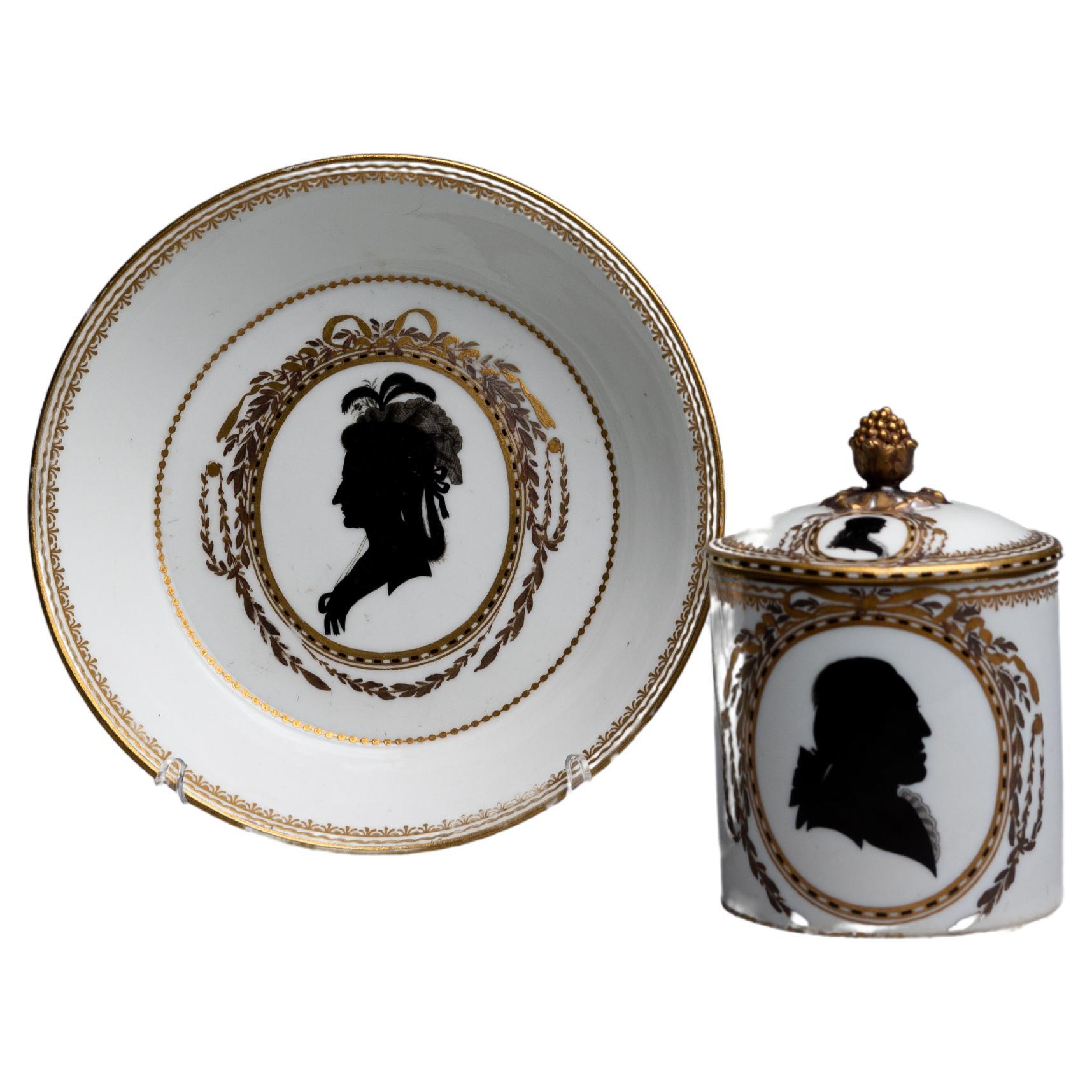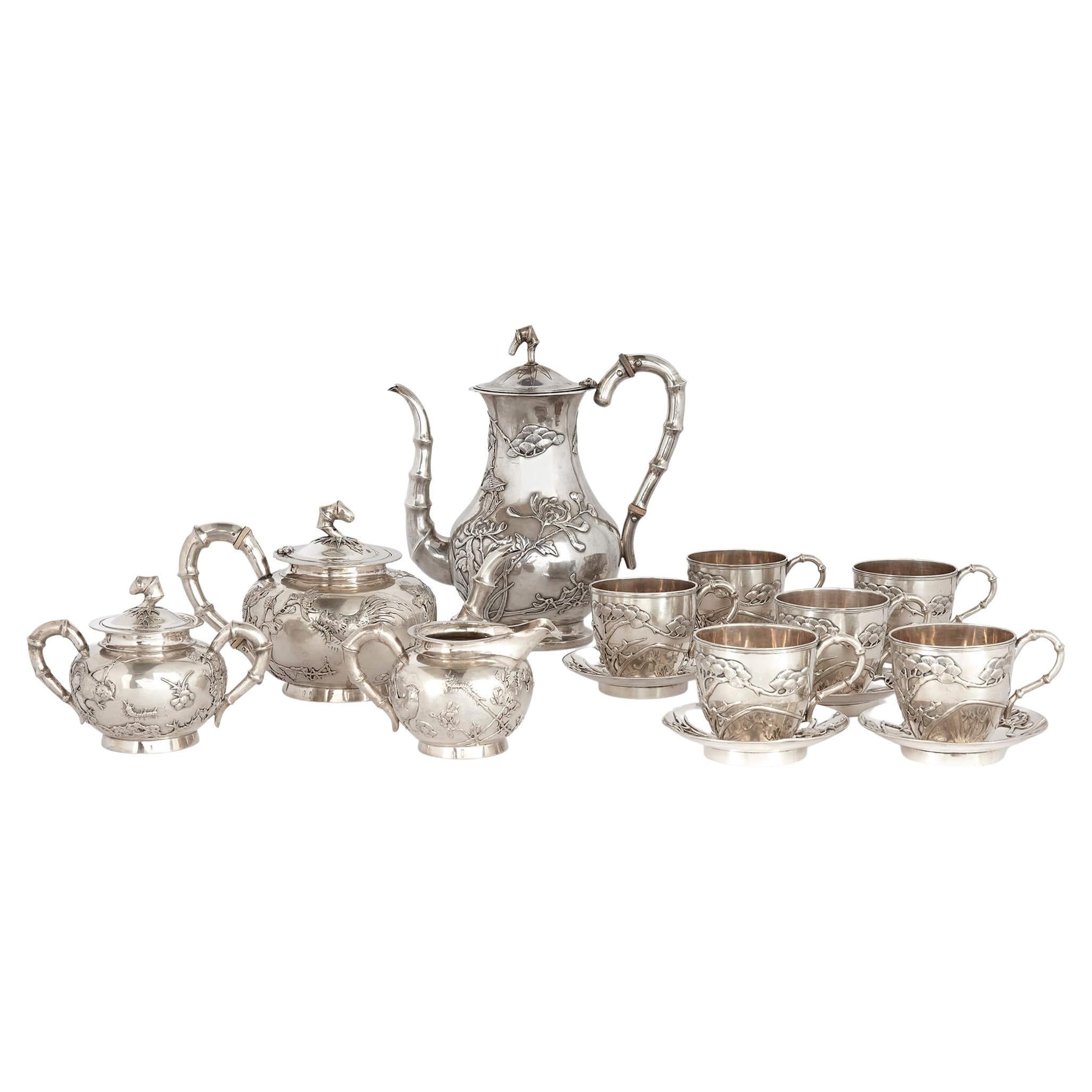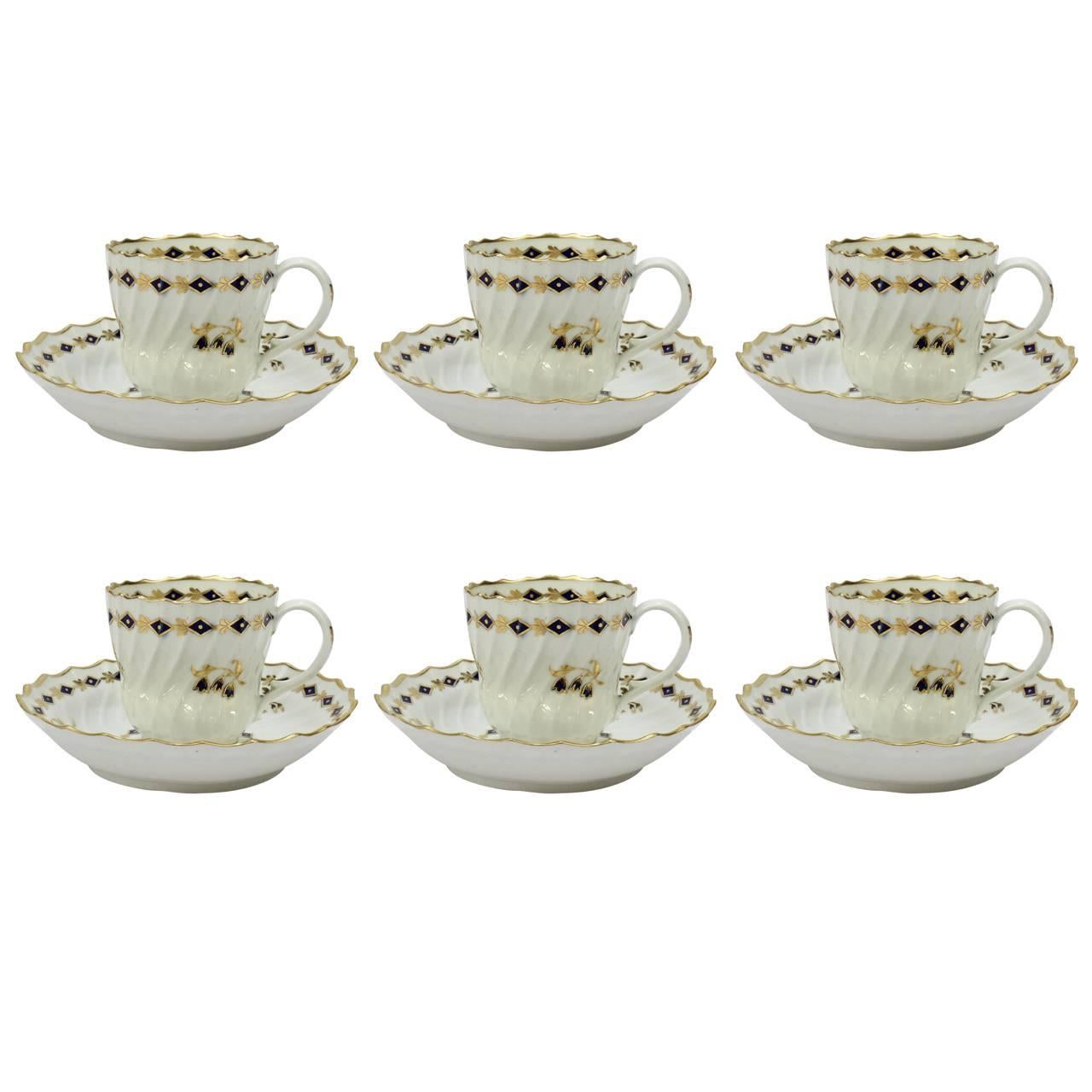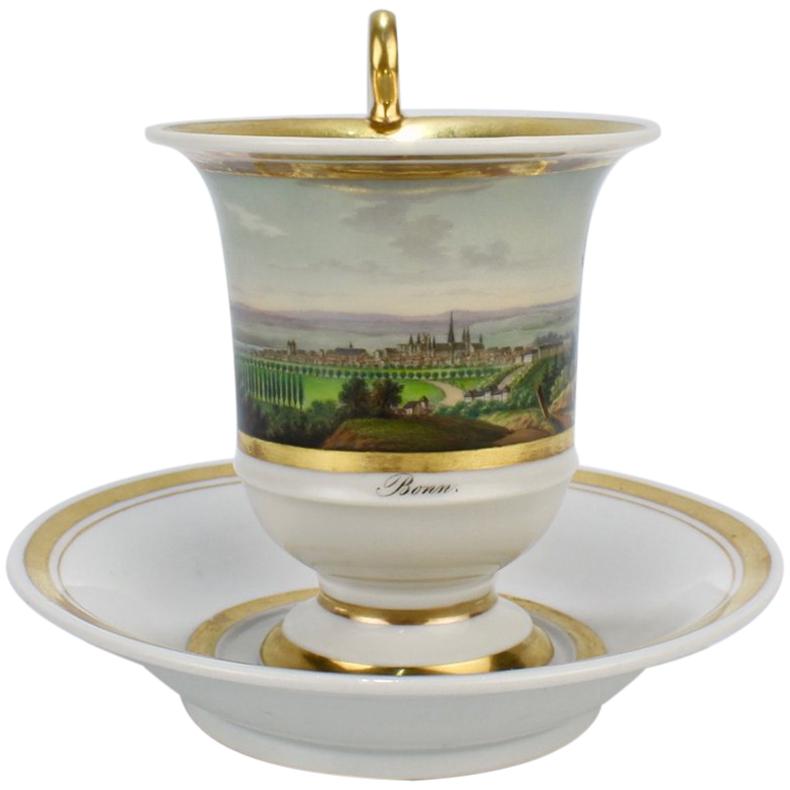Items Similar to Rare Chinese Tonkin Ware Cup-and-Saucer, Early 18th Century
Want more images or videos?
Request additional images or videos from the seller
1 of 2
Rare Chinese Tonkin Ware Cup-and-Saucer, Early 18th Century
About the Item
A Chinese made tonkin ware gilt- and lacquer cup and saucer
China or Japan, Chinese artisans, early 18th century
The black-lacquered cup with gilt handles in the shape of sculptured chrysanthemums and a lobbed edge decorated with gilt engraved border, with a gilt foot-ring that fits into the saucer ring, with two cartouches showing partly undercut gilt relief trees and birds on a gilt granulated background, black lacquered bracket-lobed edge, depicting gilt engraved peony scrolls and three cartouches decorated with high relief gilt trees and birds on a gilt granulated background, the centre with engraved chrysanthemum, enclosed by a raised ring upon which the cup fits, around which a circular panel decorated with high gilt relief trees, flowers, birds and a butterfly on a gilt granulated background.
Measures: Cup: H. 5.7 x W. 8.5 cm
Saucer: Diameter 13 cm
Provenance:
Collection Felix Schäfer
Note:
The decoration of the cup and saucer is identical to the slightly smaller cup and saucer in the collection of the Rijksmuseum Amsterdam (inv. No. NG-1994-37-1/E). In a still life painting by Pieter Gerritszoon van Roestraten (1627-1700), three pairs of similar Sawasa cups and saucers are depicted (Sawasa, Japanese export art in black and gold, 1650-1800, Rijksmuseum 1998, fig. 12).
- Dimensions:Height: 2.25 in (5.7 cm)Diameter: 5.12 in (13 cm)
- Sold As:Set of 2
- Style:Chinese Export (Of the Period)
- Materials and Techniques:
- Place of Origin:
- Period:
- Date of Manufacture:1700-1715
- Condition:Wear consistent with age and use.
- Seller Location:Amsterdam, NL
- Reference Number:1stDibs: LU5458220878632
About the Seller
5.0
Vetted Seller
These experienced sellers undergo a comprehensive evaluation by our team of in-house experts.
Established in 1985
1stDibs seller since 2020
19 sales on 1stDibs
Typical response time: 3 hours
- ShippingRetrieving quote...Ships From: Amsterdam, Netherlands
- Return PolicyA return for this item may be initiated within 7 days of delivery.
More From This SellerView All
- Rare Chinese Tonkin Ware Shakudo Sawasa Erotic Tobacco BoxLocated in Amsterdam, NLA ruyi-shaped Shakudo-style erotic tobacco or snuff box, relief-decorated with silvered applied figures Possibly Jakarta (Batavia), first half 18th century Measures: H. 2.2 x L. 12.1 x W. 8 cm This box is very much in the Dutch taste, for the illustration is after a print with a legend reading “L’oiseau sans cage. Prenez, belle, mon oiseau. C’est le plus doux présent que je puisse vous faire. Pour les autres oiseaux, la cage d’ordinaire est une espèce de tombeau. Mais le mien semble prendre une nouvelle vie, Lorsqu’il sera dans la cage de mon aimable Silvie.” The erotic message is as clear as can be. In Dutch culture the verb ‘vogelen’ (catching a bird) is another word for having sex and a bird escaping from his cage indicates loss of chastity. The lady with the bare breasts, while making the sign of sealed lips to the lady behind her, who is pointing towards heaven, seems to be caressing the bird held in the sleeping man’s groin. 17th century Dutch pictures...Category
Antique Early 18th Century Chinese Chinese Export Metalwork
MaterialsGold, Silver, Bronze
- Pair of Fine Islamic Silver Filigree Rosewater Sprinklers, Early 18th CenturyLocated in Amsterdam, NLA pair of very fine silver filigree rosewater sprinklers Possibly India, Karimnagar, early 18th century Height 31.6 cm and 31.7 cm, weight 39...Category
Antique Early 18th Century Indian Islamic Metalwork
MaterialsSilver
- Fine Indian Silver Filigree Casket with Hinged Cover, 18th CenturyLocated in Amsterdam, NLA pair of very fine silver filigree rosewater sprinklers Possibly India, Karimnagar, early 18th century Measures: Height 31.6 cm and 31.7 cm,...Category
Antique 18th Century Indian Metalwork
MaterialsSilver
- Five Extremely Rare Chinese Drawings of Foreigners, 18th Century, ColonialLocated in Amsterdam, NLFive Chinese paintings of western people by an unknown artist China, circa 1760, captions later All in giltwood frames. “A woman with Portuguese hairdo, with gold, silver and gemstone necklace, a skirt under a vest, a koi on her back, called a cloak, a woman customarily inherited the family business, the male humble, to the threshold (Qianlong year, circa 1735).” Gouache on silk, measures: 32 x 25.4 cm “He is a Westerner who had a white skin. He does not have a heavy beard but plaits his hair. He wears a triangular black hat, short jacket, leather shoes and long stockings...Category
Antique Mid-18th Century Chinese Chinese Export Paintings and Screens
MaterialsPaper
- Splendid and Heavy Late 17th Century Dutch-Colonial Silver Filigree SalverLocated in Amsterdam, NLA splendid and heavy Dutch-colonial silver filigree salver Indonesia, Batavia (Jakarta) or possibly Padang, West Sumatra, 2nd half 17th century Diam. 22.9 cm Weight 551 grams This filigree-work was probably done by Chinese masters...Category
Antique 17th Century Indonesian Dutch Colonial Metalwork
MaterialsSilver
- Dutch Colonial Silver Dish with the Von Pfeffel Coat-of-arms, 17th CenturyLocated in Amsterdam, NLAn unusual Indonesian lobbed silver dish Jakarta (Batavia) or Coromandel coast, third quarter 17th century, apparently unmarked The eight lobbed dish exuberantly decorated with floral motifs, with the middle section replaced, consisting of indistinctly marked German silver from the early 19th century, bearing the coat-of-arms of the Von Pfeffel family. Diam. 30.5 cm Weight 461 grams Note: Lobbed silver dishes with exuberant floral decorations were characteristic of the decorative arts in the Netherlands in the first half of the 17th century. This style of floral decoration was adopted by silversmiths as well as by furniture makers working on the Coromandel Coast and in Batavia, often by workers who had fled the Coromandel Coast because of war and famine. In Batavia this style was known as “Custwerck” (work from the Bengal coast). These lobbed dishes are seldom marked. Only after 1667 the use of the town mark became obligatory in Batavia but only for silver made in Batavia not for silver imported in Batavia from other VOC settlements. The engraved coat of arms in the centre is a replacement of the original centre. The coat of arms can be identified as those of Christian Hubert von Pfeffel (1765- 1834). As a diplomat, statesman, ambassador of Bavaria in London and Saxony and councillor to the King of Bavaria, he was made “Freiherr” in 1828 and since then used this coat of arms. His son Karl Maximilian Friederich Hubert Freiherr von Pfeffel (1811-1890) in 1836 married Karoline Adelheid Pauline von Rottenburg (1805-1872), the natural daughter of Prins Paul von Württemberg (1785-1852) and his mistress Margrethe Porth. Paul was the jounger brother of the King Wilhelm I of Württemberg (1781-1864). The heraldic motto of the von Pfeffels Vur Schande habe den Huot means as much as “Beware of Shame”. Christian Hubert Theodoor Marie Karl von Pfeffel Karl Maximilian’s grandson was the last male in the von Pfeffel line. His daughter, Marie Louise (Paris in 1882 - Cornwall 1944), born and grown-up in France, changed her name in de Pfeffel. She was the great grandmother of Boris Alexander de Pfeffel Johnson, the present British Secretary of State. None of the members of the von Pfeffel family had any direct links with the Dutch East Indies but indirectly by way of the Royal House of Württemberg they did. Sophia Frederika Mathilda von Württemberg (1818-1877), daughter of Wilhelm I King of Württemberg, in 1839 married Willem III...Category
Antique Late 17th Century Indonesian Dutch Colonial Sterling Silver
MaterialsSilver
You May Also Like
- 18th Century Meissen Marcolini Silhouette Cup and SaucerBy Meissen Porcelain, Gottlob Samuel MohnLocated in Fort Lauderdale, FLA Meissen porcelain cup and saucer from the Marcolini period, dating around 1795, decorated with silhouette designs attributed to Samu...Category
Antique 1790s German Neoclassical Tea Sets
MaterialsPorcelain
- Antique Japanese Porcelain Cup & Saucer Imari 'Flowers", 18th CenturyLocated in Amsterdam, Noord HollandAntique Japanese Porcelain Cup & Saucer Imari 'Flowers"", 18th Century. Very delicate and nicely painted set. Additional information: Material: Porcelain & Pottery Type: Tea Bowls ...Category
Antique 18th Century Japanese Tea Sets
MaterialsPorcelain
- Silver Chinese Export Tea and Coffee Service, by Tuck Chang & Co., ShanghaiBy Tuck Chang & Co.Located in London, GBSilver Chinese Export tea and coffee service, by Tuck Chang & Co., Shanghai Chinese, Late 19th century Measures: Milk jug: height 8cm, width 14cm, depth 10cm Coffee pot: height 25...Category
Antique Late 19th Century Chinese Chinese Export Tea Sets
MaterialsSilver
- Set of Six 18th Century Flight Worcester Porcelain Tea Cups and SaucersBy Flight, Barr & Barr WorcesterLocated in Philadelphia, PAA set of six antique Flight Worcester porcelain cups and saucers. Each with a ribbed swirl design and cobalt blue and gold floral sprig and garland decoration. Each base is mar...Category
Antique Late 18th Century Great Britain (UK) George III Porcelain
MaterialsPorcelain
- Early 19th Century Biedermeier Period Topographical Porcelain Cup and SaucerBy Meissen PorcelainLocated in Philadelphia, PAA fine antique German Biedermeier period topographical porcelain cup and saucer. The front decorated with a finely hand painted depiction of ...Category
Antique 19th Century German Biedermeier Porcelain
MaterialsPorcelain
- Chinese Export Silver Three Piece Tea Service, circa 1900By Luen WoLocated in Jesmond, Newcastle Upon TyneAn exceptional, fine and impressive antique Chinese export silver three piece tea service; an addition to our diverse silver teaware collection This exceptional antique Chinese silver tea service...Category
Antique Early 1900s Chinese Chinese Export Metalwork
MaterialsSilver





